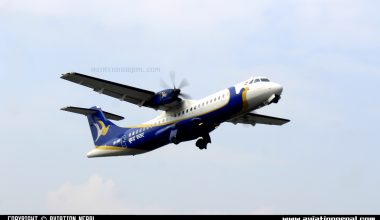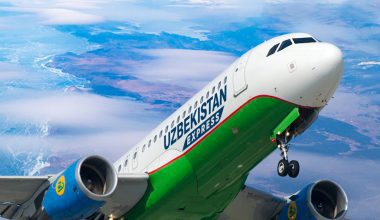Are you aware of the reasons why airplanes are banned from flying over Mount Everest? Commercial airlines avoid air paths that fly directly over Mt. Everest or the Himalayas as a whole. The Himalayas are the mountain ranges that constitute the highest peaks of the world, including Mt. Everest. Himalaya Mountains have an altitude of more than 20000 feet, in which Mt. Everest, being the highest mountain in the entire world, stands 29037 feet high above sea level.
Most scheduled airlines avoid taking fly routes over Mount Everest. Jet aircraft fly at an altitude from 35000 to 40000 feet; the height of Mt. Everest is inside the jet plane’s cruising altitude.

To ensure a safe distance above the Himalayas, the pilots are required to fly into the lower portion of the stratosphere. Based on temperature, the stratosphere is situated above the earth’s weather, where the air level is exceptionally low. The level of oxygen is also thin. When the air is less dense, then at a certain altitude, there comes a moment when enough air can’t pass through the engine, and there’s no enough power generated to climb the plane up; there’s no enough thrust.
Everest flying means a reduced level of oxygen, which can lead to hypoxia, hence an inadequate situational awareness of passengers and crew members.
Similarly, low oxygen can be the condition for air turbulence. Air turbulence is a major source of anxiety and notorious discomforts for air passengers. The chaotic movement of air causes the aircraft to roll, yaw or pitch. To add up to the discomfort, wind velocity is also so substantial in that area, and mountains’ presence leads to difficult maneuvering on the aircraft.
Clean Air Turbulence can’t be seen by eyes and is challenging to pick up on the radar, complicating to spot it. Clean Air Turbulence isn’t entirely predictable and occurs in Everest, as it happens above 15000 feet altitude caused by fluctuation in the air velocity in the jet engine. It can contribute to accidents inside the cabin. The passengers may be thrown out of the cabin as a result of not wearing the seatbelts as the plane moves through turbulence. Mt. Everest creates mountain waves downward from the mountain ridges, which can create fluctuation in the aircraft performance, which can give rocking movement to the airplanes.

The Himalayas and Mt Everest are rugged, capped with snows, with almost no flat surfaces. There’s a risk of sudden cabin depressurization. It is risky to perform an emergency landing on land without flatness, and there are mountains all around. Airlines usually carry oxygen to use in emergency cases which usually last for 20 minutes. You can’t imagine being out of oxygen. If the aircraft runs out of oxygen, to replenish it, the flight needs to descend from its cruising altitude to at least 10000 feet, which is almost an impossible act to perform in the Mt. Everest area. There are rules concerning flying that compels the operators to descend to 10000 feet prior to the aircraft giving out the oxygen. The Everest region of Asia is such a big area, and there would be a large swath that would not be possible to escape that fast.
Inability to lower the plane in case of sudden decompression isn’t always the reason preventing aircraft from overflying Mt. Everest. The aircraft have strict rules regarding their pathways above the ground. The windy and snowy conditions of Mount Everest create the probability of white-outs, where the pilots are not able to see at all.
Mt. Everest is one of those peaks, along with few other Himalayan peaks which can pierce jet stream-powerful winds at high altitude, the steadiest wind belt in the upper troposphere. Weather conditions are extreme in the Mt. Everest region. The winds can exceed 2000 miles per hour occasionally and intensifies when triggered by some weather conditions. The movements of the subtropical jet streams can cause a wide range of weather ranging from constant wind shifts to monsoonal rains.
You can’t make an error in this region. If you encounter a mechanical or technical problem and require an emergency landing to fix it, it’s devastating to know that there’s no flat surface to bleed off the altitude. Mountains aren’t the ideal places as a runway.

As the Everest region is a low-populated area, radar systems are not much developed. Radar is of utmost importance to ensure aviation safety and improve aircraft operational efficiency. Without almost non-existent radar infrastructure in the area, pilots can’t communicate with the ground to inform the flight conditions.
Another reason concerning why airplanes are banned from flying over Mt. Everest is the India-China relation. There are no often commenced flights between India and China. Western China doesn’t require air transport much due to its low population, and the flight services which are operated between these two countries don’t take flight paths over the Himalayas. Military restrictions also exist for flights flying over Mt. Everest. The military bases for the training of the Indian Air Force and People’s Liberation Air Force in the Tibetan area don’t allow commercial air operations. China only permits Chinese airlines to access over Tibetan side of the Himalayas.
The other reason why airplanes are banned from flying over Mt. Everest is that there are no airports where airplanes can divert easily from Everest. This is a further issue for commercial airlines. Lhasa’s Gonggar Airport’s runway is 4000 meters, and Tribhuvan International Airport of Nepal has a runway of 3350 meters. The absence of available airports nearby to make urgent landing complicates flying over Mt. Everest.
The Himalayan region is a complicated geographical region, imposing several safety challenges for the aircraft. It is an exceptional area possessing many young mountains, deep valleys, snows, and ices. There isn’t much flyover traffic in this part of the world. There are not many city-pair connections that demand flying over the Everest side. What needs to be borne in mind is that what’s possible isn’t regularly practicable. Some domestic flights of Nepal take tours, heading into the high Himalayas.
The other determining factor for the restriction in overflying Mt. Everest is the possible fuel freeze in aircraft. When you cruise at a high altitude, the weather conditions start becoming colder. The jet fuels used in aircraft can freeze at -47 Degree Celsius, which is possible above Everest, as the altitude is high. The aircraft must descend to the lower altitude where there’s a warmth to avoid the problem of fuel freeze. But there’s no room for choosing that option while overflying Mt. Everest. So to avoid fuel freeze at such a high altitude, the pilots should not overfly Everest.
Mt. Everest, the pride of Nepal on the crest of the Great Himalayas, as it stands out in glory with its head high, lies on the border between Nepal and Tibet. There lies the problem within the area, i.e., extremely high mountain ranges. The airports on the mountainside sit on a slope usually ravaged by heavy crosswinds. Pilots need special certification to land at such an airport. Unpredictable weather in the mountainside is a real concern for the pilots for dealing with low visibility and powerful winds. A small mistake can be crucial enough to lead to accidents in such an arena.

Low pressure amounts to a decrease in air resistance and available drag, due to which the aircraft can’t slow down swiftly while landing. Flying over the Everest region has never been easy. Himalayan terrains vary rapidly, causing abrupt variation in obstacle height on the part of pilots. As density altitude increases, the performance of airplanes reduces.
So many factors like terrain, wind, weather, loss of situational awareness are imposing threats to the safe flying of commercial jets over Mt. Everest. The mountain aerodromes can also pose a threat.
Flying over mountains is demanding; amateur pilots need to consider their background and experience before opting for a flight over Mt. Everest terrain, although they stretch up pilots’ ability to navigate the flight properly and deal with weather conditions proficiently. Even the experienced pilot can someday be trapped in a situation that requires immediate action.
What should be considered while flying over the mountains?
When flying over the mountains, some factors are required to be considered. They are weather factors (density altitude, pressure, mountain waves, winds, microbursts, temperatures, etc.). Many things such as supplemental oxygen onboard, signaling devices must be kept ready. Strong winds and the resulting up and downdrafts can limit the pilot’s ability to react to it.
So both safety reasons and military reasons are involved in restricting aircraft flying over Mt. Everest. To summarize, the key factors to ban flying over Everest are:
• Air turbulence
• No flat terrains for an emergency landing
• Risk of sudden cabin depressurization
• No place for mistakes
• Lack of situational awareness
• Military reasons
• Mountain challenges and the possibility of fuel freeze
• No easy airports






